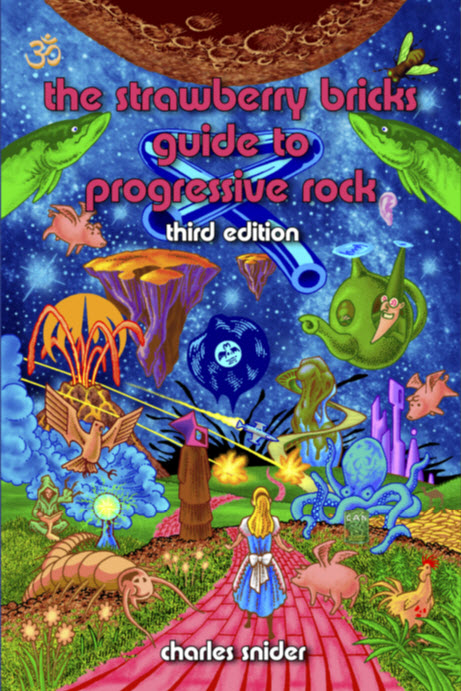
Exposé Online
What's old
Exposé print issues (1993-2011)
- 1 (October 1993)
- 2 (February 1994)
- 3 (May 1994)
- 4 (August 1994)
- 5 (October 1994)
- 6 (March 1995)
- 7 (July 1995)
- 8 (November 1995)
- 9 (March 1996)
- 10 (August 1996)
- 11 (February 1997)
- 12 (May 1997)
- 13 (October 1997)
- 14 (February 1998)
- 15 (July 1998)
- 16 (January 1999)
- 17 (April 1999)
- 18 (November 1999)
- 19 (May 2000)
- 20 (October 2000)
- 21 (March 2001)
- 22 (July 2001)
- 23 (December 2001)
- 24 (April 2002)
- 25 (September 2002)
- 26 (February 2003)
- 27 (August 2003)
- 28 (December 2003)
- 29 (April 2004)
- 30 (September 2004)
- 31 (March 2005)
- 32 (September 2005)
- 33 (May 2006)
- 34 (March 2007)
- 35 (January 2008)
- 36 (October 2008)
- 37 (July 2009)
- 38 (July 2010)
- 39 (Summer 2011)
Reviews
Charles Snider — The Strawberry Bricks Guide to Progressive Rock, 3rd Edition
((Not on label) , 2020, Book)
by Peter Thelen, Published 2020-03-27

It’s hard to get a concise definition of what progressive rock is, and equally important, what it isn’t. Whether it be a style of music, or an attitude about music, or some other concept related to the music, everyone who claims knowledge as to what progressive rock is, has their own ideas regarding what qualifies as such, myself included. First off, I have never seen the first or second editions of Strawberry Bricks Guide, but this third edition has much to recommend, although for someone already well into this type of music, one has to wonder what the value would be. One might suspect that its value would be greatest to someone in the midst of the discovery process, who may know some of the recordings detailed herein, but certainly not all. For that person, the Strawberry Bricks Guide presents a fountain of knowledge that will open a listener's mind to other music of this type well beyond what they already know. The book is over 570 pages, with well over 500 albums reviewed; Snider’s reviews are very scholarly, interspersing the music at hand with bits of history regarding the artists, and quite often the review of one LP will also include information regarding other releases, before or after, by the same artist, which brings that 500 number up to a thousand or more. Another unique aspect is the order of presentation in the form of a timeline, beginning in 1967 with The Beatles' Sgt. Pepper’s and following a month-by-month timeline that finally ends with the first album by Asia in 1982. Through this, the reader, who might have not even been alive at the time, can experience the development of progressive rock as it unfolded through the years, up to through the end of the timeline, at which point it’s clearly past its sell-by date and on life support. It’s an innovative way to present the music, and one that does it far more justice than the encyclopedic approach.
The author sets his limits early on in the section preceeding the timeline, that progressive rock began as a British phenomena and includes only those artists who were British, or European and American artists influenced by British progressives during the timeline presented. Sad, then that the first US entry is Kansas’ Song for America in 1975, all of the rich bounty of US progressive music prior to that (Zappa, CTA, Byrds, Kaleidoscope, Spirit, HP Lovecraft, It’s a Beautiful Day, Touch, Santana and many others) are summarily ignored, though to be fair, this book is already close to 600 pages – add that stuff in and it would be approaching a thousand pages or more. So the author has defined the limits of coverage, and as such he has done a superb job covering the most important releases from that period. In the Epilogue section the author quickly summarises the period from 1982 to the present in about 14 pages, with quick mentions of Marillion, Porcupine Tree, and many other next-gen prog bands, as well as his section on prog festivals that brought many of the old bands back from the dead for reunions, playing alongside newer underground bands copping prog styles from an bygone era before they were born. In summary, this is an excellent, innovative and scholarly approach that analyzes the timeline of the progressive rock era.
Filed under: New releases, 2020 releases
Related artist(s): Charles Snider
More info
http://strawberrybricks.com
What's new
These are the most recent changes made to artists, releases, and articles.
- Review: Ektör - Ektöristan
Published 2025-12-31 - Release: Chatte Royal - Mick Torres Plays Too F***ing Loud
Updated 2025-12-30 15:33:15 - Artist: Chatte Royal
Updated 2025-12-30 15:32:15 - Release: Olly Chalk - In Those Remote Stars
Updated 2025-12-30 14:01:10 - Artist: Olly Chalk
Updated 2025-12-30 13:59:56 - Review: Pietro Zollo - The Future Is Now
Published 2025-12-30 - Release: Dhope - Musical Exhibitions
Updated 2025-12-29 23:00:53 - Release: Tin Pan Alley - Tin Pan Alley
Updated 2025-12-29 22:51:10 - Release: Jeff Pearce - Infinite Ambient: Winter Landscapes
Updated 2025-12-29 22:33:12 - Release: Trio of Bloom - Trio of Bloom
Updated 2025-12-29 17:19:40 - Artist: Trio of Bloom
Updated 2025-12-29 17:16:50 - Artist: Craig Taborn
Updated 2025-12-29 17:02:15 - Release: Family - Old Songs, New Songs
Updated 2025-12-29 00:03:41 - Review: The Kirkbys - It's a Crime: The Complete Recordings
Published 2025-12-29 - Release: Various Artists - Psychedelic Underground 20
Updated 2025-12-28 23:33:26 - Artist: Dhope
Updated 2025-12-28 23:27:49 - Artist: Tin Pan Alley
Updated 2025-12-28 23:21:39 - Release: Various Artists - Psychedelic Underground 19
Updated 2025-12-28 23:04:15 - Review: Earthbound - Earthbound
Published 2025-12-28 - Review: Olgoj - A Place to Rest
Published 2025-12-27
